Manipuri Style
Manipur is a green, fertile and mountains surrounded land of unusual beauty.
This is the valley of the Serpent God inhabited by the people considering human
life and nature God’s gifts, dance and music
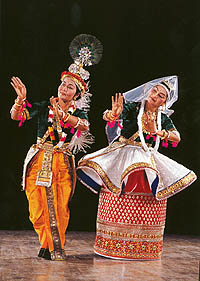 being the most beautiful and the
most natural ways of expressing gratitude. Every event, be it birth, wedding or
death is the reason for a beautiful ceremony and gives men, women and children
the opportunity to become witnesses to and participants of a professional
dancing and musical ritual. being the most beautiful and the
most natural ways of expressing gratitude. Every event, be it birth, wedding or
death is the reason for a beautiful ceremony and gives men, women and children
the opportunity to become witnesses to and participants of a professional
dancing and musical ritual.
Manipur is the land where myths and legends coexist with almost scientific
explanations of phenomena, where a complex system of prophecies is a neighbor to
wide knowledge and the deepest philosophy. These different influences are united
in harmony in everyday life. Rituals are not just formal ceremonies detached
from simple people’s needs. In the same house you can see both sacred objects
that are the evidence of spiritual aspirations and a loom to satisfy purely
economic needs. But the most important thing is that every man feels his unity
with nature, dances and songs being the proof of it.
A beautiful legend of Nongpokningthu and Panthoibi, the deities similar to Shiva,
explains the meaning of the name Manipur. When Krishna and gopis (shepherdesses)
performed Raaslila, Krishna invited Shiva to see that nobody bothers them. Shiva
was very eager to see their ecstatic dance but Krishna did not allow and only
let him to stand near the gates to the dancing ground and Shiva swore that he
would stand with his back to the dancing all the time. Shiva kept his word but
the intoxicating sounds of Krishna’s divine flute and gopis’ foot bells did not
give him a moment’s peace.
He shared this with Parvati and together they decided to create their own
Raaslila. Coming down from their Himalayan dwelling place they found a
fairy-tale valley full of water. Shiva threw his mighty trident into the slope
of the mountain. The water poured out through the outlet and then Shiva and
Parvati started to dance in joy, and Ananta the divine serpent took jewels off
his hood and with their help lit the valley. The shining of those jewels gave
the name to the valley under which it is known today – "Manipur" or the land of
precious stones.
The gods and goddesses’ creative work is the basis of another legend. It tells
how the Almighty rubbed his right hand and created nine gods, and then he rubbed
his left hand and created seven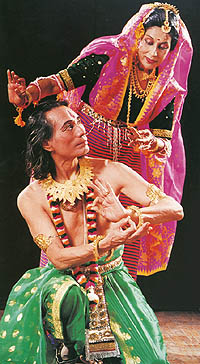 goddesses. Gods and goddesses started to dance
and with their motions they created the matter and then created piles of ground.
After creating seven piles they took a rest and refreshed themselves with food
and water. Sixty of such piles were created; gods and goddesses took rest after
each eighth pile. At the same time they measured units of time that still exist
today. Pung that means "a pile of earth" is both a measure of time and a drum
that beats the temporal cycle. The people of Manipuir’s cosmic conceptions and
the laws of existence are interwoven into this myth. Up to the present day no
foreign influences could bury the tradition of ritual playing of the story of
the world creation. The chain of traditions in Manipur is unbreakable and
unchangeable. goddesses. Gods and goddesses started to dance
and with their motions they created the matter and then created piles of ground.
After creating seven piles they took a rest and refreshed themselves with food
and water. Sixty of such piles were created; gods and goddesses took rest after
each eighth pile. At the same time they measured units of time that still exist
today. Pung that means "a pile of earth" is both a measure of time and a drum
that beats the temporal cycle. The people of Manipuir’s cosmic conceptions and
the laws of existence are interwoven into this myth. Up to the present day no
foreign influences could bury the tradition of ritual playing of the story of
the world creation. The chain of traditions in Manipur is unbreakable and
unchangeable.
The cult of Vishnu became dominant in Manipur in the period of the
philosopher-king Bhagya Chandra’s reign (1759-1798). This is an extremely
important period in the history of Manipur culture. Bhagya Chandra left memories
of himself as of an enlightened king deeply devoted to God. He was called Bhakta
Rajarishi or the king-ascetic. There are records that he succeeded in poetry,
dance, music and philosophy as well as in the arts of governing, war and
administering. These qualities combined in him with humbleness, compassion and
generosity. It is not surprising that folk legends ascribe to him all human
virtues.
During Bhagya Chandra’s reign Manipur undergone the attack of the Burmese.
Notwithstanding the fact that Manipur offered the fierce resistance the might
and the overcoming forces of the Burmese were decisive and Bhagya Chandra was
made to escape and seek refuge with Svargadeva the king of the neighboring state
Tekhow. According to legends, leaving Manipur after his defeat Bhagya Chandra
danced a ritual dance with a spear (thengao) on a rock that dangerously hung
over a high precipice. Because of the strong wind raging in the valley it was
not easy even to stand on the rock. Bhagya Chandra’s dance was interpreted as a
divine blessing and an omen of his return to his kingdom.
Kings and queens of Manipur traditionally were competent in dance and music. A
queen could dance on the same ground with simple people. Dance was not just a
form of entertainment. That was an offering to gods and there were no castes and
barriers of social position on a dancing ground. Kings were supposed to embody
the subtlety of aesthetic taste; the rulers rivaled with their predecessors and
encouraged the development of oratory, poetry, dance and music. That’s why talas
are still identified with the rule of separate kings that helps to arrange them
chronologically and watch their development.
A legend says that King Bhagya Chandra was sanctified by the grace of God and
Lord Krishna himself is said to appear before him in a vision and wished that
dancers and musicians of Manipur performed Raaslila. Inspired by Krishna’s image
Bhagya Chandra learned that there is a banyan tree out of which the god’s image
must be carved. The king and the elders headed for the search of the tree but
could not find it for a long time; they were almost desperate when all of a
sudden they heard a boy playing flute in the wood. Considering this a god’s sign
the king kept on searching until he met a poor family living in an old house in
the far corner of the wood. They found the huge banyan tree near the house. When
they began to cut it the tree started bleeding. The tree was delivered to the
capital and Krishna’s image was cut out and sanctified amongst prayers and
common rejoicing. This image became sacred for the vishnuit cult in Manipur.
Organizations that grouped around Krishna’s temple and the royal court were the
keepers of artistic, administrative, religious and literature traditions in
Manipur. Their role continues to be vital for they form a supreme organ that
keeps up the highest level of studying, interpretation and practical use of
everything that is based on traditions. These organizations are respected by the
most outstanding learned men and performers who consult for example brahma sabha
on arguable religious questions, pandit loysankh on arguable tradition matters
and pala loysankh on dance and music questions. Even the kings of Manipur have
always respected these organizations for their decision was final. Their
jurisdiction covered protocol and ceremonies in relation of kinds of art, they
observed the correctness in rituals.
Tantric influence is strong in the culture of Manipur. It finds its expression
in a shivaist legend of the
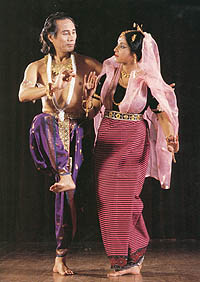 world creation. The process of creation was called
Ley tai nongtai jagoy or "the marriage of heaven and earth". There is a popular
belief that dance and its origin are closely connected with the creation of the
world. A performance based on this legend is a constituent part of Lai haraoba a
thoroughly thought-out festival of dance and music. Laipou, the dance of
creation is still performed on every Lai haroba festival in its primordial form.
Annoyrol, a ritual dance described in ancient Manipur texts is performed on this
festival too. This allows to trace the origins of dance that goes back to satya
yuga or the legendary age of piety, and to hayichika or the period when
according to a belief the worshipping of fire, of this purest and the most
ancient among all known forms of deity, started. world creation. The process of creation was called
Ley tai nongtai jagoy or "the marriage of heaven and earth". There is a popular
belief that dance and its origin are closely connected with the creation of the
world. A performance based on this legend is a constituent part of Lai haraoba a
thoroughly thought-out festival of dance and music. Laipou, the dance of
creation is still performed on every Lai haroba festival in its primordial form.
Annoyrol, a ritual dance described in ancient Manipur texts is performed on this
festival too. This allows to trace the origins of dance that goes back to satya
yuga or the legendary age of piety, and to hayichika or the period when
according to a belief the worshipping of fire, of this purest and the most
ancient among all known forms of deity, started.
The Lai haraoba ritual reproducing the process of the creation of universe
begins with the proclaiming of the primordial Nothing or the Void. Then appears
"water": men dressed in white and women in clothes with pink stripes carry
offerings and cloths down to the river. These men and women, maiba and maibi,
according to tradition are the high priests and priestesses of Manipur. As great
connoisseurs of sacred texts and the ones who mastered the art of prophets they
are the main characters in all ceremonies. Golden and silver things embodying
earth and heaven are sacrificed to water. The people of Manipur summon its
divine energy with music.
When a deity becomes implanted in a maibi’s body it starts to speak with her
mouth. It is solemnly followed back to the temple under the loud accompaniment
of trumpets sounds. On the way dancers demonstrate their art in honor of the
deity three times. The next days of ceremonies, dance and music go according to
a strictly prescribed ritual. Winding lines are drawn on the ground, various
dance ceremonies take place, and they are believed to bring prosperity to
village.
Hicham hirao, a ceremony with a boat is another important ritual that also
includes dance. A boat is a symbol of life, god and travel through life. A
tantric dance thengao is inserted in some places of Lai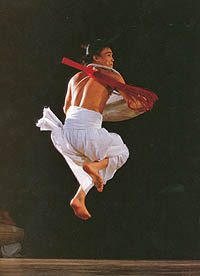 haraoba. Performers are
required to go through exhausting trainings. Since a wonderful possession of
body, balance, power and concentration are generally claimed of dancers, thengao
is considered the highest form of dance art among the experienced performers.
Their reputation often depends on how they master thengao. haraoba. Performers are
required to go through exhausting trainings. Since a wonderful possession of
body, balance, power and concentration are generally claimed of dancers, thengao
is considered the highest form of dance art among the experienced performers.
Their reputation often depends on how they master thengao.
Sankirtan is an ancient tradition in dance and music, the storage of rasa bhava,
classic ragas and talas. Thematically it is based on a legend about Krishna
though its prototype araibapala sankirtan was dedicated to Rama. In the reign of
Bhagya Chandra a number of compositions in honor of Krishna greatly increased,
this period is considered the resurrection of sankirtan tradition. Nata
sankirtan literally means "singing and dancing in honor of Hari". Its
performance is considered the highest form of worshipping. People approaching
the place of sankirtana first bow down before it and then before spectators.
Sankirtan is performed even during a wedding ceremony, since according to a
tradition it replaces fire usual for other regions of India. It depends on a
ceremony and occasions what sarkitan to perform.
In sarkitan any of 64 rasas can be used, all just being Shringara rasa
variations after all. A legend of Krishna and Radha is often played and each
performance must include rajamel or the divine unity of Krishna and Radha. This
is the symbol of unity of purusha and prakriti (male and female energies) and
the creation of the world. During the performance of rajamel the cymbals which
dancers hold in hands are never completely parted from each other.
Raaslila is a theatrical action dedicated to Krishna’s deeds. There are five
kinds of it: Maharaas, Vasantraas, Kunjaraas, Nityaraas and Divaraas. Some of
them can be performed only in a certain season, others at any time.
Before any Raaslila there is a sankirtan. Actors greet arangpham (Master of
Ceremonies) and after receiving his permission they start the performance.
Arangpham embodies Paurnimasi, Radha’s friend who performed the first lila in
Vrindavan. Drummers usually take their shirts off, bow down to the deity and
then to all the present: elders, teachers and all the rest. Singers and other
musicians do the same. The drummers begin arranging a raga and then they are
joined by singers and musicians playing on a shell. The singers sing about
Vrindavan, the place, the time, and the circumstances that are reconstructed in
the performance. When they get down to description of Krishna an actor playing
this part begins abhisaar or trip to meet his beloved (a child usually plays
Krishna and his part begins not long before 9 o’clock in the evening). He comes
out into the middle of the ground, dances and moves towards the temple under the
north gates. The whole Raas must be over till the first ray of the sun.
All parents want their children to take part in Raas and it is desirable for the
children to play Krishna or Radha. Parents are ready to bear expenses. The main
part of expenses is taken by parents of Krishna, then Radha’s, Paurnamasi’s and
Chandravali’s parents, then by the parents of the four girls near Radha and
finally by the parents of other gopis who probably only pay for the costumes of
their children. These monetary contributions are spent on decorations and
ornaments for mandapa (dancing ground) on paying to professional actors and
musicians and guru with his pupils who had been preparing children for their
parts for several months. It is a hard task to teach little children. A teacher
who prepares a boy chosen to play Krishna’s part must teach him such difficult
songs and dances as abhisaar, krishnattan, a duo with Radha and how to speak
with gopis. He must also prepare him for bhangi paren with participation of
other dancers and singers. Ojkha or the main guru conducts a general management:
he devotes himself to children by walking from one classroom to another because
everybody needs him. Thus children of various ages are taught to play
corresponding parts and those who have inclinations for that continue to perfect
their playing all their lives through. In time they become professional dancers.
A day before Raas begins the organizers gather the participants for gopibhojan.
During this ceremony the teachers receive clothes, money, food and kheer (sweet
dish). This is a touching gathering of all those who had worked together to
achieve the common goal for almost half a year. Perhaps a guru was very strict
to children during teaching and sometimes even gave beating to the boy playing
Krishna. But now the honourable guru is the example of faith and humbleness, he
bows down low before Krishna-child and says: "You have taken upon you the image
of the God I honor. Forgive me for the pain I have given you". For all the
participants the day of Raas is special. Children are bathed carefully and
dressed for the evening performance. They are treated as little gods and
goddesses.
It is necessary to note that a Manipuri dancer must keep the unique lightness in
motions and strict
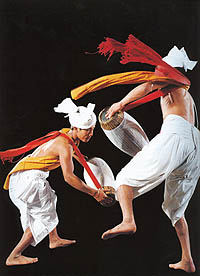 restraint whatever difficult the dance is and whatever
physical efforts it demands. Perhaps in this is the key for understanding the
style. There are no sharp motions. One motion transforms into another creating a
sensation of endlessness. A soft change of scenes leads to smoothness and
continuity in body movement what is so characteristic of this style. In Manipuri
the difference between tandava and lasya is very visible. restraint whatever difficult the dance is and whatever
physical efforts it demands. Perhaps in this is the key for understanding the
style. There are no sharp motions. One motion transforms into another creating a
sensation of endlessness. A soft change of scenes leads to smoothness and
continuity in body movement what is so characteristic of this style. In Manipuri
the difference between tandava and lasya is very visible.
Female performances of this dance are exclusively lyrical, tender and soft.
Though at first sight the motions of male dancers do not claim special efforts,
supplies of great physical strength are hidden behind the exterior endurance.
Even when men perform fast dances with swords and spears that claim maximum
energy, a dancer’s strength can be felt in only stylized and restraint motions.
So, outwardly Manipuri is a non-effective style. All figures form a single whole
transforming one into another, the harmony of body motions renders the spirit of
dance. Only maibis’ dances slightly differ from the others as there are more
swaying motions and jumps.
Manipuri is never aggressive but tender and restraint. The exaggerated use of
pantomime contradicts its norms. All motions both horizontal and vertical are
circular and transform one into another, forming spiral combinations. Arms and
hands must be incredibly flexible. Not a single motion, mood or thought contains
completeness. Body motions are not fixed and rendered by a slight hint. One is
claimed to possess strain and training to give Manipuri its seeming shape of
lightness. Great efforts hide behind every move. That’s why an accident
spectator may not understand this dance.
There are certain compositions in Manipuri which are traditionally passed down
from generation to generation. They are called parenas and contain almost all
possible motions and figures of the style. They are considered unshakable.
Parenas only come across in the part of the dance called jagoi as for instance
in Raaslila or in Goshtalila.
The whole specter of the dance is divided into jagoi, cholom and thangta. Jagoi
is performed by dancers of both sexes as for instance in Raaslila or in Lai
haraoba. Choloms are performed under the accompaniment of drums and cymbals.
They may be extremely vigorous and tender. accompaniment of drums and cymbals.
They may be extremely vigorous and tender.
For the ceremony to be a success every dancer’s specialization in a certain
aspect of dance is extremely important. A dancer, a singer, a drummer, a
cymbals player, everyone has his specific role and each of them needs serious
training.
There are no specialized schools so ojkha or guru teaches children at home. If a
child makes progress and needs further specialization his guru asks another guru
to take it upon himself. The approach to teaching is informal. In the very
beginning ojkha does not clarify or explain the details of the dance and does
not recommend any manuals. The ceremony of dedication is held on the first day
of classes or later when the most important ragis are explained to a pupil.
Students acquire subtleties by watching carefully. The most important thing is
to give them the right mood rather than the right technique which they will get
acquainted with later.
The connection between motions of dancer’s legs and tala or rhythmic cycle is
extremely important. There is no necessity to beat the rhythm with foot. Rhythm
is often only outlined. At the same time the main rhythmic points are strongly
emphasized. Dancers do not have bells on ankles because the jump may finish when
there must be no sound. Rhythmic points can be marked by a movement of a foot,
an ankle, a knee and a hip or even by a jump. Masters of dance may consider foot
stomping in a rhythmic point too elementary.
In Manipuri’s nata sankirtan about 100 talas are known. Only 60 of them are
widely used. They are not just rhythmic cycles but also the main musical
accompaniment. Beating complex rhythmic patterns on various drums, cymbals and
even by hands is an important element of Manipuri. Male singers playing cymbals
perform palacholom by bending their knees. They slightly bow forward without
bending backbone and moving legs apart. This is an important element of a male
style. A dancer saves the position even performing complex motions when he
raises his leg or executes turns and jumps.
The manner of singing and the vocal culture of Manipuri differ from other styles.
A singer usually has high and clear voice. Manipuri singers have never needed
microphones for their voices are loud enough to be heard by 3000 people.
There are four types of percussions: pung (drum), dholak and dhol (also kinds of
drums) and khandjuri (a small one-piece drum). Claps of hands play important
role in the rhythmic accompaniment. Various dances or choloms require various
techniques of performance.
Children taking part in sankirtan put on pink clothes with black narrow stripes
on the edges and white
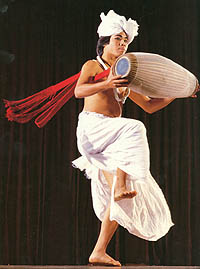 scarves. Men put on white dhotis and two kinds of turbans.
The drummers have small turbans (koyetmachi) on made of especially thin muslin.
They are carefully washed and starched. The singers have extremely complex
turbans koiechubas. Tying them is a complex art in itself and respected
professionals devote themselves to this. The sankirtan performers must be
irreproachably neat. They put on sacred threads or beads on their naked chests.
The drums are wrapped in the muslin similar to that the turbans are made of,
because drums are believed to be live creatures and thus need clothes. scarves. Men put on white dhotis and two kinds of turbans.
The drummers have small turbans (koyetmachi) on made of especially thin muslin.
They are carefully washed and starched. The singers have extremely complex
turbans koiechubas. Tying them is a complex art in itself and respected
professionals devote themselves to this. The sankirtan performers must be
irreproachably neat. They put on sacred threads or beads on their naked chests.
The drums are wrapped in the muslin similar to that the turbans are made of,
because drums are believed to be live creatures and thus need clothes.
Manipuri uses simple decorations but they create fantastic atmosphere. A round
dancing ground does not allow using backstage or large decorations that would
cover the action from the audience at least from one side. However, using the
principles of the perspective and the dance technique allow transferring the
impression of the depth, distance and sizes to the audience.
Today Manipuri is performed by single dancers and by small groups beyond the
state boarders where it was born. It has turned into the kind of art with
professional performers ready to perform both in their own country as well as in
front of a foreign audience. Even though Manipur dwellers are very jealous about
traditions and the heritage, they were able to satisfy the increased interest in
this style by playing excerpts from ancient ceremonial dances and various
performances. Famous gurus developed choreography for new compositions where the
traditional dance technique is preserved.
Manipuri is a lively tradition; the dance style is in the close connection with
the everyday life. Because of the fact that Manipur is surrounded by mountains,
it has been relatively unavailable till recently, its culture did not meet full
understanding. But the truth is that on the earliest phases of its development
the arts of Manipur achieved high level of complexity, every historical period
made its considerable contribution to the development of arts. Just like the
literature of Manipur, the traditions of its dance meet the highest standards of
classicism and elegancy.
Based on the book "Rhythm In Joy" by Leela Samson
| 